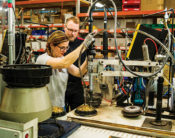A shift is happening in how manufacturers think about being profitable and growing sustainably. No longer are the bottom-line numbers simply a reflection of how many orders were placed in the last quarter; instead, companies increasingly recognize that leadership, employee engagement and customer satisfaction are all key drivers behind a good balance sheet. They’re taking a closer look at tying company strategy to production floor tactics, and at examining how the daily management of an organization drives sustained profitability.
Enterprise Minnesota’s core service offerings—Strategy for Growth, Talent and Leadership, Peer Councils, Continuous Improvement, and ISO Management Systems—are each vitally important to the success of a business. But to achieve sustainable profits and growth, an organization must approach this puzzle holistically and with an understanding of how each piece integrates with the other in terms of company strategy, management system and daily tactics.
- Strategy for Growth: Setting the vision and priorities; figuring out where the business is going and how to get there
- Talent and Leadership: Growing skills in leadership and developing engaged employees
- Peer Councils: Gaining honest perspectives from your peers; working on the business instead of in it
- Continuous Improvement: Maximizing time utilization and achieving customer value, employee satisfaction and business satisfaction
- ISO Management Systems: Management methods—grounded in strategy—to deploy and execute business objectives at all levels
Steve Haarstad, Abbey Hellickson and Greg Langfield are Enterprise Minnesota business growth consultants that guide manufacturers through each service offering and developing holistic solutions for growing profitably. While each consultant works in a specialized area—Steve on the Strategy piece, Abbey on Talent and Leadership, and Greg on Continuous Improvement and ISO Management Systems—all three integrate their work with Peer Councils and with each other’s service areas to bring comprehensive solutions to Enterprise Minnesota clients.
To learn more about how manufacturers are approaching the challenge of growing profitably and sustainably, we interviewed the three of them about the connections between strategy, management systems and tactics.
How do you help clients think about distinct areas as an integrated whole?
Haarstad: Each area of Enterprise Minnesota’s consulting adds value to the other, and that’s something that’s often overlooked. A business may need individual help in one area, but we’re finding that the more we can bring our consulting services together and blur the lines between individual services, the more value we can bring to our clients and the better performance they can get out of their business. That said, the service wheel is deliberately oriented with Strategy at the top. You need to start with Strategy and understand who you are and where you’re headed. Once you have that established, you can work on the other areas, but it is important to always link the work back to the Strategy.
Langfield: All of the service areas help an organization grow profitably, but looking at them together helps leaders think about the business holistically. For example, Continuous Improvement isn’t something you just go off and do. A manufacturer should think about the connections that need to be established across each service area in order to have long-term sustainment with profitable growth.
How do you define profitable and sustainable growth?
Hellickson: It’s critical for an organization to have foundations in all of the service areas in order to be successful and sustainable. One area alone won’t help you reach profitable or sustainable growth. But whatever service area you’re working with at the time, the work should come down to three components: the customers, the business, and the employees. To achieve sustainable growth, a leader should think about how he or she meets each of those three components’ needs.
Langfield: Customer satisfaction is about top-line business results and whether you are meeting customer expectations; business satisfaction is about cash flow and whether the business is healthy; and employee satisfaction covers attracting and retaining talent. Lots of companies miss the employee satisfaction part when thinking about growing profitably. For example, I worked with a manufacturer that was struggling to make money, which means they had an issue with cash flow and therefore the “business satisfaction” piece. But I discovered that one of the causes was their labor force. Employees thought they were doing the right thing, like taking 45 minutes to clean up a work area. That made the employee feel good, but it wasn’t doing anything to satisfy the customers or the business. So, how does leadership ensure that an employee knows what’s important and when it’s important? Employees want to show up and do the right thing, but sometimes there’s weakness in how we communicate priorities. Profitable growth is making sure employees at every level know what they need to do every day.
How do employees know what to do every day? What does that look like in practice?
Hellickson: The core of any business is Daily Management; that’s what translates the vision of a Strategy into the day-to-day reality and tactics for employees. You have to have a plan for Daily Management to sustain your efforts within each of the service areas and ultimately achieve profitable growth.
Langfield: The principle elements of Daily Management are Engagement, Action, and Sustainment. Although Steve, Abbey and I work in different service areas, we challenge companies to think about those three areas no matter their current priority. For example, how do you connect Action to vision? How do you make something Sustainable with accountability and follow through? You need to think about it from more than one area.
Haarstad: Daily Management is where the rubber meets the road. It’s the actions, behaviors, systems and tools that a company uses to carry out business. It’s how companies find ways to make small improvements and leverage solutions or ideas from all of the service areas. It’s the methodology of making it all work on a day-to-day basis.
How do you define Engagement?
Hellickson: We define Engagement as employees knowing what the business is trying to accomplish, they know their role in that, and they are active participants in the business. When we work with clients, we ask leadership, “What conversations do you have to empower employees?”
Langfield: The Gallup Engagement Hierarchy visualizes how to transform employees into participants. Engagement is all about communicating the why of the vision, setting expectations, following up or having accountability conversations regarding those expectations, and developing employees to be stronger problem solvers. This is where Continuous Improvement (CI) and the idea of small, incremental steps are really important. At the employee level, Engagement rarely happens if you ask them to think about big ideas. But when we ask them for small ideas that could improve the little, every day things… that’s when Engagement happens. Ask them to look at the things that don’t add value and go after that, no matter how small it may seem.
Haarstad: The small things make a really big impact for overall Engagement in an organization.
How does Engagement lead to Action?
Langfield: Daily Management takes each of the Enterprise Minnesota service areas and connects them to what employees are doing on the floor. It’s what’s being done every day to drive the business forward.
Hellickson: The right Action happens when leaders clearly communicate the priority of the day to employees. That’s the goal. Employees have to know how to prioritize properly so they can get the right things done. For example, I worked with a leader who was frustrated that an employee was doing inventory when everyone else was focused on getting product out the door for a big customer. After I asked the leader a few questions about why the employee might be prioritizing inventory over a large order, the leader realized he had told the employee on Monday that—“no matter what”—inventory had to get done that week. He never communicated that the product order was now the priority.
Haarstad: Action in terms of Daily Management is about doing things the right way. The little things make a big impact and small tasks add up to take us where we are trying to go. When an employee is taking Action that contributes to the profitable growth of the company, they get a sense of accomplishment. When leadership communicates correctly, the outcome is that employees are doing the right thing, at the right time, in the right way.
So, an employee doesn’t have to have a really big idea to make an impact?
Langfield: We want employees to have any idea and share it. Engagement is about rewarding the little ideas for Action and taking the time to listen. Valuing employees’ opinions increases Engagement. Leadership should be looking for ideas as to what’s non-value add for employees, the business or customers. Or ideas for value-added changes. It’s helping the employee see him or herself as a problem solver.
How does a company achieve the Sustainment portion in a Daily Management approach?
Haarstad: Sustainment is the committed and disciplined effort toward the attainment of a goal while embracing and learning from both success and failure. In practice, this means leading and supporting people to help them solve problems.
Hellickson: There isn’t just one tool that leads to Sustainment. There are many solutions within the service areas that, when combined with this perspective of Customer, Employee and Business, can help support Sustainment.
Langfield: Some examples would be daily huddles or the Leadership Team Approach or the Visual Workplace, which is using visuals to represent a standard and help employees instantly recognize what’s normal and what’s not. The key is discipline.
Can you explain those examples a bit more?
Haarstad: The Leadership Team Approach is about having leaders who are actively involved. You can’t manage by spreadsheets. This approach fosters commitment and discipline through three areas: Go & See, which gets leadership out onto the floor to see the value-add and non-value add process steps; Employee Focus, which is an approach of questioning employees to learn from them rather than telling them what to do; and Defined Priorities, which helps define and align priorities and makes sure they are communicated to employees daily. The Visual Workplace is having visuals in place that help us make an improvement because they signal what’s normal and what’s not. With a visual production floor, employees should be able to quickly see when something isn’t right.
“Daily huddles tell employees how the week is going and communicate daily priorities. It’s a way to sustain the good actions of employees so they feel engaged, because they know which actions to take. It’s all connected.”
-Greg Langfield
Langfield: Nothing can be sustained without daily huddles. You have to communicate and measure how you’re going to have a good day. Using visuals like red and green dots communicates that quickly. Did everyone go home safe? That’s a green day. Did the product miss metrics? That’s a red day. Daily huddles tell employees how the week is going and communicate daily priorities. It’s a way to Sustain the good Actions of employees, and they feel Engaged because they know which Actions to take. It’s all connected.
According to the 2019 State of Manufacturing® (SOM) survey, 48 percent of manufacturing executives said the biggest impediment to growth was attracting qualified workers; and only 49 percent were enthusiastic about the future performance of the U.S. economy.
How can an integrated approach to growth help buffer these challenges?
Langfield: I believe both challenges are addressed through an increased focus on employee productivity. The SOM results also reveal that 54 percent of companies say maximizing productivity is the top thing they are doing “to navigate around the worker shortage challenges.” However, they are investing little in leadership training: Only 38 percent of metro-based companies and 35 percent of non-metro based companies make a modest investment in leadership training. Enterprise Minnesota’s integrated approach is relevant to the potential slowing down of the economy. If a slowdown does occur, I see this as really no different than the worker shortage challenge. Companies still need to ensure that employees are doing the right work at the right time. In fact, during an economic slowdown it becomes even more important to focus on these areas to ensure the bottom line is protected.
Hellickson: The principles supported by the service areas of Engagement, Action and Sustainment promote stronger workplace environments. With Engagement, in January 2019 the Gallup organization found that companies who score in the top 20 percent for employee engagement have 59 percent less turnover and 41 percent less absenteeism. Enhancing engagement from both the leader and employee level makes a significant impact on recruitment, retention and the bottom line. In fact, these organizations outpace competitors with 21 percent higher profitability, according to statistics from Forbes in 2019.
With Action: When employees know what’s expected of them at work, it creates the foundation for strong engagement. You cannot foster a strong workplace that attracts and retains employees without communicating the priorities that require daily action.
And finally, Sustainment: Organizations that are sustaining their initiatives and fostering continuous improvement are building higher levels of engagement and attaining higher profitability. When you’ve created accountability within the organization, you’re at a higher level of engagement, which results in increased attractiveness and tenure.


